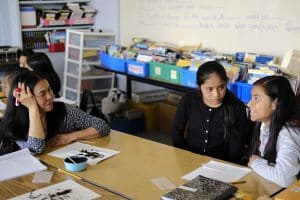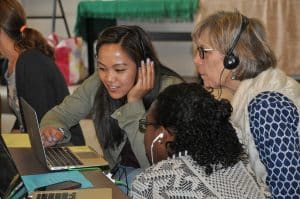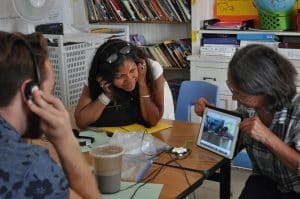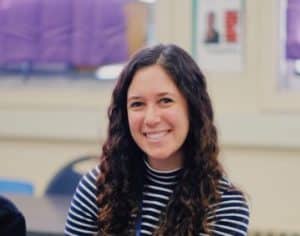Develop a Practice of Learning Partnership Conversations to Center Student Voice in Professional Learning
CompetencyWorks Blog
“I feel like my students don’t want to do the assignment”
“Today was a great day in class, it seemed like everyone was engaged.”
“I always teach the same end-of-year unit, and I think students like it.”
“Based on their last exam, most students are doing fine.”
Read the list above. How many of these statements have you said aloud? In your head? When I was in the classroom, I said forms of all four at various times. Only when my school partnered with Lead by Learning and later when I began working with the organization, did I look between the lines of each phrase and confront the fact that all were based on assumptions and implicit bias. All four statements needed to be unpacked further if I was to provide the educational experience each student deserved to reach their goals. I couldn’t do this alone, however; I needed my colleagues’ support, and I needed data.
At Lead by Learning, we have a question we center during every professional learning space we facilitate: “What is happening for my learners, and how do I know?” This question asks educators to take a new approach – one grounded in curiosity, not compliance – to answer this question with the support of our students.
This invites us to expand our definition of data beyond dashboards and proficiency scores, which only illustrate what needs improvement, but do not tell us why or how the student is experiencing the learning. In order to redesign our education system as competency-based education asks us to do, we need to include student voice as a catalyst to understand what is happening for students and their learning. Students’ needs are constantly changing. There is not one way to learn or a set amount of time for learning to occur. Knowing who our students are, where they are in their learning, and why is integral to designing equitable, competency-based classrooms and schools.

We do this through an approach that we call the Learning Partnership Conversation. It is a form of student data that creates a pathway to equity because it empowers students as partners in their education. Instead of thinking, “I feel like my students don’t want to do the assignment,” and stopping there, it supports educators to investigate further, challenge that assumption, and talk to students about what they are experiencing.
The Learning Partnership Conversation invites educators to become curious about what is happening for students and then partner with 2-4 focal students or learners to understand how they are progressing based on their learning. By partnering with those learners throughout the school year or a designated amount of time, both the student and the educator are providing each other with individualized feedback. The conversation is focused on what the educator needs to find out to ensure equity and, in doing so, enables them to unpack the assumptions that commonly get in the way of progress. The Learning Partnership Conversation, as the name states, is about partnership. This may be a new interaction for the teacher and student, so it is important to remind the student that what they say and share will not impact their grades and that as the educator, one is there to listen and learn, not judge or evaluate.
While I was in the classroom, my colleagues and I embedded this practice as a professional learning routine, which created the conditions for us to voice our assumptions aloud during professional learning time. When enabled to do this, we regularly asked each other: “What is happening for your learners, and how do you know?” We then followed the question up with, “Have you asked your students?” Nine out of 10 times we had not asked them, yet. It was not that I did not want to, but, as an educator, so much is happening each minute of every day. By having the structures in place during professional learning time to support each other to return to our students as partners, we could stay committed to the classroom adaptations we wanted to make.
I have learned it is inadequate and actually tone-deaf at times for leaders to just say to educators, “listen to students” or “just ask them” without an acknowledgment of all that is on an educator’s plate and all the ways they are already collecting information rapidly in formal and informal ways. It is important for school leaders to integrate student voice data intentionally into professional learning in routine ways. In doing so, leaders create a bridge for educators to turn to innovative data in supportive ways that allow Learning Partnership Conversations to weave into an educator’s practice instead of stacking on top of all they are already doing. Below is a guide to get started with Learning Partnership Conversations.
Step 1: Identify the purpose of your Learning Partnership Conversation: notice your assumptions about your practice, student learning, and student experience.

The first step in learning is self-awareness. What do I know? What do I not know? What assumptions may I behold? What do I need to find out? When we can identify this, we can identify the purpose of the Learning Partnership Conversation and what questions we need to ask our focal students to guide our investigation.
This step is easier said than done. My organization, Lead by Learning often supports educators to reflect first independently and then share these reflections in pairs and triads during professional learning time. The sole purpose is to help the colleague who is sharing to see what they can’t see on their own: some of their assumptions. Having a few colleagues model this sharing and listening for the whole group before breaking into smaller pairs or triads can help lower colleagues’ self-consciousness or defenses so they can more readily be open to feedback and learning, thus increasing their willingness to share vulnerably and take risks.
“My students are continuing to not master their writing skills. I have tried different strategies such as providing more writing time in class, choice around writing topics, and different writing scaffolds but nothing is making a difference. I thought they had the skills and I do not know what is getting in the way of their mastery. I feel like there is nothing left I can do.”
Let’s take this response as an example:
The educator has shared that they know:
- Students are not mastering the writing skills.
- The various techniques they have tried.
The educator shared they do not know:
- What is preventing the students from success.
An assumption the educator is making is:
- The strategies tried are the only strategies.
What the educator needs to find out:
- What has helped students master writing previously.
- What strategies work and do not work for each student.
- What other strategies the student would like.
- What is getting in the way for students.
Step 2: Identify your focal students.
With this new degree of self-awareness, it is time to identify which students and learners to partner with and what questions to ask. The goal is to understand your students’ thinking process and how they are currently experiencing learning to unpack the assumptions you may have previously made. At Lead by Learning, we have a core mindset that equity requires questioning assumptions.
When selecting focal students, it is important to be intentional about who you choose and their connection to the question you seek to answer. Below are three points to consider when choosing your focal students.
- Choose 3-4 learners: It is important to seek out various perspectives. Approach your choice with an equity stance: Consider which learners or groups of learners are historically underserved in your school or classroom, and which students represent different needs, challenges, or perspectives. Using other data sources such as student work samples or assessments pertaining to a focal competency, language proficiency data, and/or individualized education plan goals can all be helpful.
- Attendance matters when choosing focal learners. Choose learners who you will be able to follow up with throughout the time period of your inquiry. We have also found that this practice can have a positive impact on student attendance due to the learning partnership it develops. For some educators this is a reason to choose a focal student with inconsistent attendance to understand their experience.
- Take a partnership stance. It is helpful to choose learners who will engage in this process and willingly share their thinking process with you. On the other hand, this is an opportunity to build, rebuild, or strengthen a relationship with a learner who may not be as willing to share at the start.
Our research has shown that students who engage in Learning Partnership Conversations report increased student agency. In alignment with competency-based education, the practice allows students and educators to work with each other and empower students to be active designers of learning. Research shows that engaging with focal students supports the learning of all students.
Step 3: Identify your questions.
Selecting the right questions is key to having an intentional Learning Partnership Conversation. One approach is to brainstorm a long list of questions first and then whittle your list down to the top 2-3 questions. We suggest having no more than three questions so that you can ask additional questions based on what your students share. We suggest using the same 2-3 questions for each interview to compare responses from one student to another. Sometimes groups of teachers may want to ask the same question across classrooms, subjects, or grade levels. To get started, below are some suggested question stems:
- What has been your experience with _____?
- What do (does) ______ mean to you as a student?
- Tell me about a time when ______.
- What usually happens for you when/during ________?
- How do you feel when you _______? Why?
- How do you feel about _______________________ in ____? Why?
Step 4: Engage in your Learning Partnership Conversation.

Start by telling the student that you are working on improving your teaching, so you can be the best possible teacher for them, and you would like their help to understand their student experience better. Share that you’d like them to be your partner in understanding.
We suggest asking students for their consent to audio record the conversation or take notes, as well as share their thinking with colleagues. We suggest removing students’ names when sharing between colleagues, just as you would when sharing student work samples. Doing so supports colleagues to focus on the data with the freshest eyes and perspectives. Remind the students that there are no wrong answers and that you are genuinely interested in everything they have to say to support improving teaching and learning for them and their peers.
Save time to reflect on the experience with the student afterward. Thank your students and ask them how it felt to share their thoughts with you. This form of student and teacher partnership might feel new for both of you. Since we highly recommend this not being a “one and done,” ask the student if you can follow up with them routinely to share your thoughts after your conversations or after you try something new based on what you learned.
Step 5: Reflect independently and with colleagues.
Debrief these conversations during professional learning time. Create space, possibly with a protocol for colleagues to share what they have been thinking about and hoped to learn from the conversation. Then listen to the data together, or read the notes or transcript, and think about what the student is sharing and how you might adapt your practice, instruction, or learning environment based on what you are learning. Allow the student’s words to join the conversation, and refrain from judging what is shared.
Step 6: Continue the practice.
I always found it helpful to regularly meet with my focal students and learners. Not only did this strengthen our relationship and allow them to share more each time, but it also allowed me to understand the impact of the changes I was making and whether I found success or not. If you are the designer of professional learning, consider inviting colleagues to engage in a Learning Partnership Conversation once in the fall and once in the spring to begin with and possibly increase the practice from there.
Remember, if we want to shift education to center learning, we must shift the ways educators are learning. Learning Partnership Conversations are one way to get started.
Learn More
- Making the Shift: Why Is It So Hard to Scale Equitable, Learner-Centered Education?
- Professional Learning Exercises for Teachers Making the Shift to Equitable, Learner-Centered Education
- What Happens When You Really Listen? Student Voices and Reshaping Policy

Nina Portugal is passionate about students, equity, and continuous improvement. Nina spent 9 years teaching High School English, 7 of which in Oakland Unified School District, focusing on English Language Development, Strategic Reading, English, and Ethnic Studies education. Prior to teaching in Oakland, Nina taught English at a bilingual high school in Spain and at a public Charter School in South Chicago. While in the Classroom, Nina focused on lifting up her student’s voices through the development of participatory politics and authentic experiences in partnership with Educating for Democracy in the Digital Age (EDDA), Youth Voices, Peralta Hacienda, and integrated project work. Nina has spoken at the California Career Pathways Consortia and California Partnership Academies Educating for Careers Conference, Connected Learning Conference, California Steam Symposium, Carnegie Foundation Summit on Improvement in Education, and ASCD Annual Conference. In 2017, Nina was named Californians for Justice Teacher of the Year and in 2020 a NBC Bay Area Sports All-Star Teacher finalist. Currently the Director of Visibility and Community Engagement, Nina is honored and excited to share Lead by Learning with educators nationwide. Nina received her B.A. in English from the University of Southern California and her M.A. in Education from Loyola Marymount University.